|
|
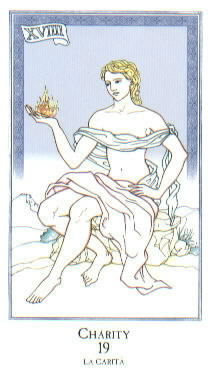 Minchiate
Tarot Minchiate
Tarot
- designer/artist/author: Brian
Williams
- publisher:Inner Traditions
- first appeared: 1999
As far as scholars can determine, tarot cards first
appeared in northern Italy in the heyday of the Renaissance.
Almost every city had their own distinctive version of the
tarot. One variation spread to France to become the Tarot de
Marseille, the classic tarot that inspired virtually all our
present-day decks, occult theories, and divination
practices. The other fascinating tarot variants, which
persisted in their native Italy for centuries, somehow
escaped the attention of everyone except art historians and
collectors of playing cards. Until now.
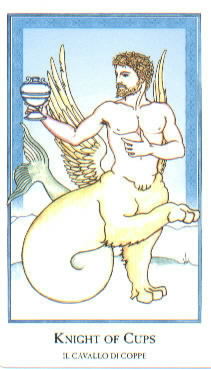 To
create this extraordinary new tarot set, artist Brian
Williams drew his inspiration from what is certainly the
most metaphysically elaborate variation to be found in the
entire history of the tarot: the Minchiate of Florence. The
16th-century Florentines expanded the system of trumps to
include all 12 signs of the zodiac, and the four elements of
earth, air, water, and fire; they augmented the three
virtues of the tarot (Justice, Fortitude, and Temperance)
with Prudence, Faith, Hope, and Charity, for a total of
seven. Perhaps in deference to the influence of Rome, the
Papess (High Priestess) was removed from the deck, and the
Pope was replaced by the Eastern Emperor. The result was a
tarot deck with 97 cards, including the Fool and 40 numbered
trumps, instead of the usual 21. But such a description only
touches the tip of the iceberg. Even the cards carried over
from the standard tarot were often redesigned; the knights,
for example, were transformed into centaurs and griffons. A
number of the pip cards sport curious little animal
vignettes, apparently based on fables and folktales. I own a
reproduction of a fancy engraved
Florentine Minchiate deck, and I use it extensively for
divination and contemplation. It is a rich and powerful
system of symbols, full of possibilities and nuances. To
create this extraordinary new tarot set, artist Brian
Williams drew his inspiration from what is certainly the
most metaphysically elaborate variation to be found in the
entire history of the tarot: the Minchiate of Florence. The
16th-century Florentines expanded the system of trumps to
include all 12 signs of the zodiac, and the four elements of
earth, air, water, and fire; they augmented the three
virtues of the tarot (Justice, Fortitude, and Temperance)
with Prudence, Faith, Hope, and Charity, for a total of
seven. Perhaps in deference to the influence of Rome, the
Papess (High Priestess) was removed from the deck, and the
Pope was replaced by the Eastern Emperor. The result was a
tarot deck with 97 cards, including the Fool and 40 numbered
trumps, instead of the usual 21. But such a description only
touches the tip of the iceberg. Even the cards carried over
from the standard tarot were often redesigned; the knights,
for example, were transformed into centaurs and griffons. A
number of the pip cards sport curious little animal
vignettes, apparently based on fables and folktales. I own a
reproduction of a fancy engraved
Florentine Minchiate deck, and I use it extensively for
divination and contemplation. It is a rich and powerful
system of symbols, full of possibilities and nuances.
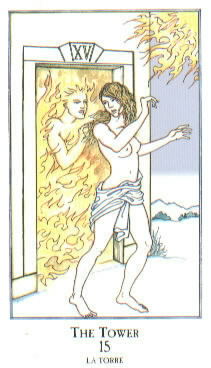 Williams,
who created the innovative and beautiful Renaissance
Tarot, as well as the irony-drenched and critically
exalted PoMo Tarot, has taken the
ancient Minchiate designs and re-visioned them for our own
time with incomparable grace and delicacy. This is the
artist's finest work to date, showing a master's fluidity
with both concept and execution. The pristine and elegant
line drawings evoke feelings of balance and inner peace
rarely found in western art, and the coloring is both subtle
and eloquent. Even the pip cards are made into suitable
objects for spiritual contemplation. It is impossible to
hurry in working with these cards. Each image calms and
directs the mind, and the resulting state of focus draws one
into the rich and layered meanings of the symbols. In the
Tower card (sometimes called The Devil's House in the
Minchiate), for example, we witness a woman poised on the
cusp of inner turmoil. Behind her, a demonic hand reaches
out from a flaming doorway. But the hand doesn't grasp her;
she is neither being pushed out or pulled in to the inferno.
Instead, she hesitates, glancing over her shoulder with a
look of perplexity, longing, and anguish. Her body is in
motion but her mind is trapped in an invisible web of
contrary impulses. Williams,
who created the innovative and beautiful Renaissance
Tarot, as well as the irony-drenched and critically
exalted PoMo Tarot, has taken the
ancient Minchiate designs and re-visioned them for our own
time with incomparable grace and delicacy. This is the
artist's finest work to date, showing a master's fluidity
with both concept and execution. The pristine and elegant
line drawings evoke feelings of balance and inner peace
rarely found in western art, and the coloring is both subtle
and eloquent. Even the pip cards are made into suitable
objects for spiritual contemplation. It is impossible to
hurry in working with these cards. Each image calms and
directs the mind, and the resulting state of focus draws one
into the rich and layered meanings of the symbols. In the
Tower card (sometimes called The Devil's House in the
Minchiate), for example, we witness a woman poised on the
cusp of inner turmoil. Behind her, a demonic hand reaches
out from a flaming doorway. But the hand doesn't grasp her;
she is neither being pushed out or pulled in to the inferno.
Instead, she hesitates, glancing over her shoulder with a
look of perplexity, longing, and anguish. Her body is in
motion but her mind is trapped in an invisible web of
contrary impulses.
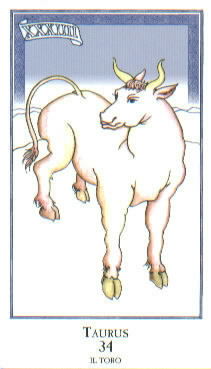 Compelling
images abound in this deck. I know astrology less than I do
tarot, but I've never felt like I "understood" Taurus. Bulls
seem like symbols of aggression and male potency to me; I
couldn't find the nurturing aspect and never saw an
illustration or explanation that helped much. The Taurus
card in this Minchiate deck, though, says it all perfectly
in a single wordless image. There are also some very subtle
impressions I'd been making use of in reading my old
Minchiate deck, such as a significant difference in poise
and attitude between the Western Emperor and the Eastern
Emperor. Williams has preserved many of these nuances,
although often expressing them through a different set of
details. Then there are the strangely evocative images of
the four elements. Earth is a serene landscape with a deer
who is not yet quite aware of our presence; Fire is a
sacrificial goat in a bonfire, Water shows a great
explorer's galleon at sea, passing an enormous whale on its
journey to some distant port; and Air shows a dog looking up
wistfully at the birds and clouds drifting high above. Compelling
images abound in this deck. I know astrology less than I do
tarot, but I've never felt like I "understood" Taurus. Bulls
seem like symbols of aggression and male potency to me; I
couldn't find the nurturing aspect and never saw an
illustration or explanation that helped much. The Taurus
card in this Minchiate deck, though, says it all perfectly
in a single wordless image. There are also some very subtle
impressions I'd been making use of in reading my old
Minchiate deck, such as a significant difference in poise
and attitude between the Western Emperor and the Eastern
Emperor. Williams has preserved many of these nuances,
although often expressing them through a different set of
details. Then there are the strangely evocative images of
the four elements. Earth is a serene landscape with a deer
who is not yet quite aware of our presence; Fire is a
sacrificial goat in a bonfire, Water shows a great
explorer's galleon at sea, passing an enormous whale on its
journey to some distant port; and Air shows a dog looking up
wistfully at the birds and clouds drifting high above.
One of the things I have long admired about Williams's
Renaissance Tarot is the way in which the human figures are
handled with both love and respect. We may not, at first
acquaintance, be ready to say that we understand what is on
the mind of the Queen of Swords, Temperance, or the Devil,
but we are confident that the artist has found their
humanity, and is inviting us to do the same. There is a
promise that there really is a subtle harmony underpinning
all the strange twists and turns of human personality. In
the New Minchiate Tarot, this compassionate and deeply
spiritual vision of the human condition is distilled and
perfected. The sense of intimacy with the figures on the
cards is stronger than it is in the Renaissance Tarot, but
somehow that heightened intimacy is achieved without
compromising their humanistic dignity.
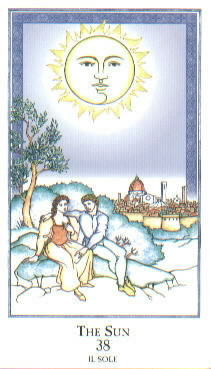 Although
the new Minchiate is an adaptation of a historic deck, the
personal vision of the artist has made it much more than a
collector's curiosity. I think modern tarot readers will
find this an excellent deck for personal healing, for
relationship work, and for tapping into those feelings of
oceanic belonging that those of us with mystical
inclinations pursue with such devotion. A deck is an
important and powerful personal item; readers may come to
resemble their decks. A deck like this, with a strong
spiritual center and the capacity to affirm human dignity
and harmonize the personality, is not something to be found
every day. Although
the new Minchiate is an adaptation of a historic deck, the
personal vision of the artist has made it much more than a
collector's curiosity. I think modern tarot readers will
find this an excellent deck for personal healing, for
relationship work, and for tapping into those feelings of
oceanic belonging that those of us with mystical
inclinations pursue with such devotion. A deck is an
important and powerful personal item; readers may come to
resemble their decks. A deck like this, with a strong
spiritual center and the capacity to affirm human dignity
and harmonize the personality, is not something to be found
every day.
This is not a deck for those who want a host of different
"symbols" on each card to interpret. You won't find secret
messages hidden in the designs of the clothing or the
placement of the blades of grass. The artwork is very light
and spacious, completely unburdened. The meaning comes
through one's esthetic impression of the whole, not through
an intellectual analysis of the individual components. This
is a deck of private reverie.
The accompanying book, like the Renaissance Tarot book,
is a treasure trove of research, insight, and gleanings from
Italian art history. Williams has again produced an
extensive collection of line drawings made from classic art
that is not generally available for our study and enjoyment.
Although it is an essential guide to interpreting the cards,
it is also, like its predecessor, an excursion into the
fascinating world of Italian art and culture. It would be
wonderful if more tarot "companion books" had something this
substantial to give us.
The Minchiate Tarot is a milestone. For many decades,
tarot use and interpretation was constrained by occult
theories based on qabala and the Tarot de Marseille. More
recently, readers are stepping outside of that framework to
experience the tarot from feminist, pagan, eastern, or
shamanistic perspectives. Along with this has come a more
intuitive, more personal way of seeking meaning in the
cards. Yet, for the most part, the decks themselves have
made only superficial concessions to these expanding
horizons. The New Minchiate Tarot reaches back to a time
when tarot was more diverse, and designers made dramatic
experiments in the symbolic system. The Minchiate was
waiting to be heard; thanks to the artistic talents of Brian
Williams, it now sings to us with clarity and profundity
across the span of centuries.
|